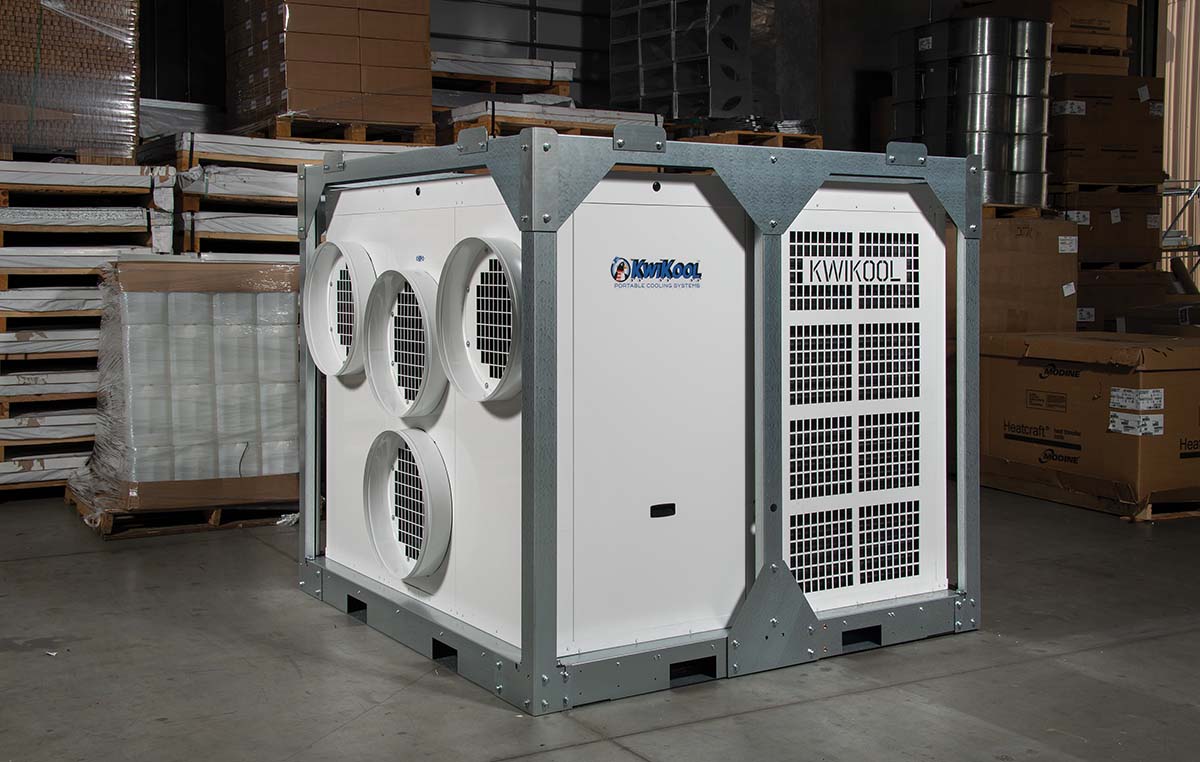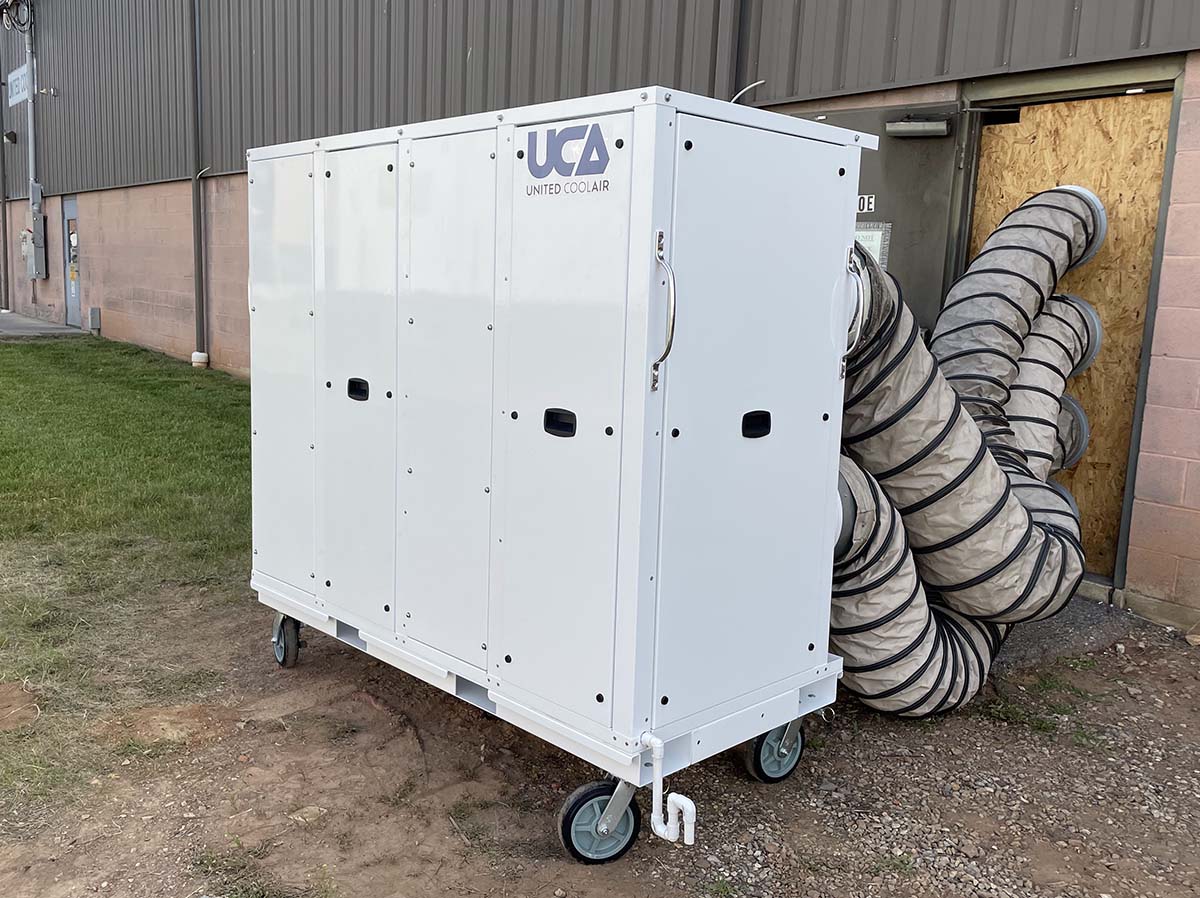vice president of sales
United CoolAir
Equipment failures, the need for backup systems in environments where cooling is essential, and lengthy lead times for permanent replacement equipment are among the current factors driving the market for portable air conditioning in commercial, industrial, and institutional settings. Demand for portable a/c units of larger capacities is growing, and some equipment now incorporates remote monitoring capabilities. Non-residential portable a/c customers include factories, data centers, healthcare facilities, schools, restaurants, and retail establishments.
Mike Renier, vice president of sales at KwiKool, and Brad Dunn, who has the same title at United CoolAir, both said that some customers are using portable a/c while they wait for permanent replacements. In some settings, such as hospitals and data centers, customers need quick cooling relief.
“Lead times for rooftop units (and) computer room a/c have been around 40-70 weeks,” said Dunn. “Hospitals, senior living care, and data centers need immediate cooling, and they have been investing in our temporary environmental control equipment. Once they receive their permanent equipment, they plan to keep our unit in case of future emergencies and breakdowns.”
Cooling Capacities
“There has been substantial growth in demand for air conditioning overall,” said Renier. But long waits for replacement a/c, he added, are fueling demand for larger-capacity, high-static portable units. High-static units are able to be connected to more ductwork for cooling larger facilities.
Comfort- and product-cooling in large spaces and precision air conditioning are the most common applications for KwiKool’s systems, Renier said.

HIGH CAPACITY: A 25-ton KwiKool portable outdoor unit with two supply flanges and two exhaust flanges. Up to four of these models can be stacked together. (Courtesy of KwiKool Portable Systems)
KwiKool’s newest model is the KPO25-43, a high-static outdoor unit. The 25-ton unit has a dual-scroll compressor, a variable-frequency drive condenser fan, two flanges for supply ducts and two for return ducts, and an evaporator fan that can push air at 9,500 cfm.
The KPO25-43 is only 6 feet wide by 6 feet deep by 5 feet tall; its small footprint “allows for getting closer to the space being cooled,” Renier said. With an optional frame, up to four units can be stacked together.
United CoolAir also has high-capacity portable units, the PACH25 and PACH30 (25 tons and 30 tons of cooling, respectively), that can be mounted either on a trailer or a skid. Each unit has six duct collars — three for supply air and three for return.
“We have expanded to larger sizes to keep up with customer demands for larger facilities or projects where much higher tonnage is required,” Dunn said.

ON THE JOB: A United CoolAir MACH145 12-ton portable unit. The MACH fits through 36-inch door openings, pushes air at more than 4,000 cfm, and can be stationed indoors or outside. (Courtesy of United CoolAir)
Applications, he said, have grown to include warehouses and manufacturing facilities, as employers in areas with high summer temperatures are looking to retain employees by increasing their on-the-job comfort and keeping them working safely.
“Additionally, if these portable units need to move to another area within the facility, or the company moves, they can take them to the next location for use,” Dunn said.
Going Remote
Jonathan Seigler is the general manager in North America for Carrier Rental Systems and Carrier’s Spot Coolers, both of which provide a/c units to a variety of non-residential customers, including stores, restaurants, schools, college and university campuses, healthcare facilities, and warehouses. Generally speaking, he said, demand is greater when customers’ existing equipment breaks down during summer months.
“We take pride in delivering air conditioners and dehumidifiers with 24/7 availability,” Seigler said, whether it’s for emergency situations or to temporarily provide cooling when permanent equipment is shut down for scheduled maintenance.
Seigler noted that one supplier, MovinCool, has introduced remote monitoring of its portable units, which allows users to track the equipment’s location, its energy usage, and the temperature in the cooling environment.
“This has been helpful as we introduce new products, and we foresee this allowing us to provide our customers with the tools they need to stay on track with their energy-usage goals and make immediate changes as their cooling needs change,” Seigler said. The data helps companies optimize the placement of the equipment, Seigler said.
Among those units with remote monitoring are those in the MovinCool Climate Pro series, available in capacities from 1 ton to 5 tons. The units can be used indoors, Seigler said, and are found in stores, commercial buildings, clinics, and college settings. They’re mounted on casters, have condensate-collection tanks, fit through standard-width commercial doors, and have wrap-around bumpers that protect against scratches and dents.
“These units can be deployed for most spot-cooling applications and can be set up and operational in a matter of minutes,” Seigler said. “They use ambient air in the environment so they do not require any special intake air system to operate.”
The heat captured by a Climate Pro unit is exhausted out of the top of the unit and can be ducted into a ceiling plenum or directed outside through a door or window, Seigler said.
MovinCool is a Denso Corp. company, and Spot Coolers was its first distributor. (Spot Coolers features products from other brands as well, including KwiKool and Therm-Air.)
Some United CoolAir portables have optional remote thermostat capabilities.
Clearing the Air
KwiKool also offers a line of portable air purifiers — the BioAir series. The units feature 4-inch HEPA filters, germicidal UV-C lighting, stainless steel cabinets, and optional ion generators for increased air-scrubbing, Renier said. BioAir units are available in 600-, 1,000- and 1,800-cfm models. Mounted on casters for portability, a BioAir unit can function in three ways: as a filtered negative air unit, which sends possibly contaminated air outside; as a filtered air clear that purifies air within the room; or as both a negative air unit and filtered cleaner, simultaneously.
“We recommend using our air purifiers in areas with a high concentration of people with close personal exposure, such as an emergency room or a school cafeteria,” Renier said.
KwiKool also has portable units, the BioKool series, that combine 1.1 tons of cooling with air-cleansing features like ULPA (Ultra-Low Particulate Air) filters and UV-C lights. KwiKool bills BioKool units as hospital-grade a/c units.
At United CoolAir, Dunn said, the company has increased the filtration level on its equipment for improved IAQ, but has found that demand for UV-C lighting has subsided since the coronavirus pandemic. Typically he said, customers that want UV-C lighting have it installed in the conditioned space externally to a/c equipment.








